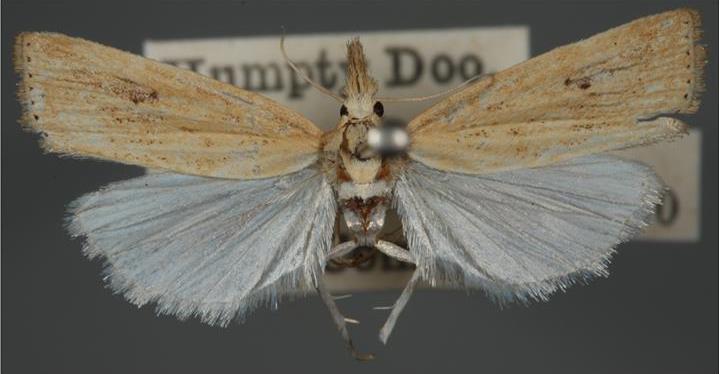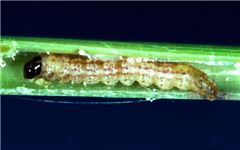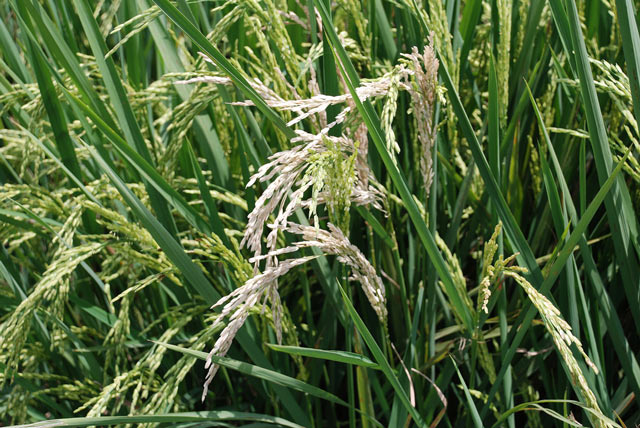
Stem borer
| Primefact number | Edition | Published | Author |
|---|---|---|---|
| 1518 | First | Aug 2017 | Plant Biosecurity and Product Integrity |



Stem borer (Chilo polychrysus) is an exotic plant pest not present in Australia. This insect is a serious threat to Australia’s rice industry.
Stem borer (Chilo polychrysus) is a stem boring insect which is a serious pest of rice. It also infests maize, sugarcane and wheat. The stem borer caterpillars damage these crops by boring or tunnelling inside their plant stems.
Notifiable status
Stem borer (Chilo polychrysus) is not a notifiable plant pest in NSW.
However, if you suspect Stem borer (Chilo polychrysus):
- Call the Exotic Plant Pest Hotline 1800 084 881
- Email biosecurity@dpi.nsw.gov.au with a clear photo and your contact details
A full list of notifiable plant pests and diseases can be found in Schedule 2 of the NSW Biosecurity Act 2015.
Description
Stem borer moths have small yellow-brown bodies with 16-25 mm wingspans. They have 2-3 dark spots on their white-yellow forewings. The hindwings are white to dirty-cream (Figure 1).
Caterpillars have dark-brown to black heads, with five purple-brown longitudinal stripes along their greyish-white bodies. Fully grown caterpillars are up to 25 mm long. Stem borers are also known as dark-headed striped borers (Figure 2).
The flat, oval, creamy white eggs are about 1 mm long. They are laid in clusters of 20-150 eggs.
Damage
Stem borer caterpillars damage plant growing points and cause “dead hearts” (the youngest still unfolded leaves wilt and die), “white heads” (empty or partially filled heads of discoloured grain) and broken stalks in infested rice crops (Figure 3).
Tunnels inside the plant stems allow other pests and diseases into the infested stalks which can increase crop losses. Infested rice stalks are easily broken by the wind.
Rice stem borers, including stem borers, are the main insect pests of rice in Asia. These pests damage 5-10% of the annual Asian rice crop, causing 80% yield losses in heavily infested crops.
Lifecycle
Stem borers have four lifecycle stages: eggs, caterpillars, pupae and moths.
Female moths lay their eggs on both sides of the host plant’s leaves. The eggs hatch into caterpillars after 4-7 days.
The caterpillars first feed under the leaf sheaths before boring downwards to the leaf base, where they penetrate the stem just above the node. They next tunnel upwards into the rice stalk.
Stem borer caterpillars are not affected by irrigation and can live in the plant stems below the paddy water levels. The caterpillars become pupae inside the stems before emerging as moths.
The female moths live for 3-4 nights after emergence, when they mate and lay their eggs on nearby plant hosts. Stem borers can have up to 12 overlapping lifecycles in a year, with each lifecycle lasting 4-7 weeks.
Host range
The main host plant of the stem borer is rice (Oryza sativa). Other hosts include maize (Zea mays), sugarcane (Saccharum officinarum), wheat (Triticum aestivum) and grasses (Poaceae spp.).
Spread
Stem borers are spread from farm-to-farm by infested planting material, farm machinery and vehicles. Caterpillars move about and within a host plant, while the moths fly between host plants at night.
Distribution
Stem borer is a native insect of Asia and is found in Bangladesh, Brunei, Cambodia, China, India, Indonesia, Laos, Malaysia, Myanmar, Pakistan, Papua New Guinea, the Philippines, Thailand and Vietnam.
Actions to minimise risks
Put in place biosecurity best practice actions to prevent entry, establishment and spread of pests and diseases:
- practice “Come clean, Go clean”
- ensure all staff and visitors are instructed in and adhere to your business management hygiene requirements
- source propagation material of a known high health status from reputable suppliers
- monitor your crop regularly
- keep records

